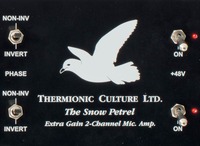
Review by Russell Cottier
The Miktek MPA-201 is a dual-channel Class-A microphone preamplifier providing a certain amount of character from its multiple transformer stages. It is one of many products from Nashville based pro-audio manufacturers Miktek, distributed in the UK by Red Chilli Audio, recently formed by Sonic8 founder Steve Helm. Miktek has a range of more utilitarian boxes on the market but this 2U rack unit that draws from classic transformer based, console preamp design definitely stands out as Miktek’s flagship signal processor.
For each channel there are four knobs, they feel fairly robust though they are based around a metal covered plastic knob rather than full metal construction. It is unlikely however that these will be damaged in normal use. Gain is controlled with a stepped switch ranging from 15dB to 70dB as one might expect from a 1073 inspired preamp. A smaller impedance selector control offers three positions 1200Ω, 600Ω and 300Ω. Next we have a high-pass filter, ranging from 18Hz to 300Hz which can be bypassed with the a adjacent illuminating button. Finally the large output knob, this is a continuously controllable potentiometer used to trim the output level as necessary. The peak meter which sits above the VU comprises three LEDs giving an absolute indication of expected clipping levels on the output. The MPA-201 seems to be marketed in part towards home recordists and a hardware clipping meter calibrated to +4dBu seems logical. However this was useful even in a professional studio environment.
The lower row of controls offers five illuminating buttons with a 1/4” jack for instrument or line level input. There are buttons for 48V, Phase flip and the Smooth control (more about that in a moment) and a metering selection option to toggle between Input and Output levels to be displayed on the VU meter. The meters are large, round and easily read. However they don’t react quite as quickly as one might expect from a VU, though the PPM style metering above will indicate clipping issues.

The rear panel is simple as expected and interestingly the power transformer is placed in its own individual chassis attached to the main unit, to keep it as far as possible from low-level audio signals. It should be noted however even with the case shielding mounting the unit near power amplifiers etc. could cause noise.
Ribbon mics like 300Ω In terms of the microphone input a wide variety of colours can be achieved with different front panel settings. Ribbon mics definitely prefer the 300Ω setting on the input stage, condensers perhaps lose a little top at 300Ω and dynamics seem to prefer 600Ω and 1200Ω settings.
The High-pass filter is smooth and easy to use, sweeping frequency is instinctive and the frequency range up to 300Hz allows for some extra tonal sculpting. The high-pass bypass was very useful for changing tones in overdubs from the same source. The Output level knobs are smooth and easy to use, since the input gain is stepped, of course the continuously variable output is necessary.

The MPA-201 has a lovely sonic, noise floor is low and microphone signals are imbued with a rather pleasing low-mid response. The manual boasts the linearity up to 100kHz of this unit but actually it is the colour that is added which is likely to be the main selling point. Signals which may sound brittle in other solid state preamps are given a rather enjoyable smoothness, and overall the results sound very professional. Very much like the kind of sound you would expect from a 1073, but with a slightly less sharp top-end in general.
Transients for acoustic guitar for instance are comfortably controlled as the transformers saturate, giving an overall pro-studio feel. Input sources such as tambourines, acoustic guitars, piano and even jazz brushed drums sound clear and detailed and the low mids are thickened harmonically enough to add a discerned weight.
The instrument input sounds beautiful, noise floor is low and even passive guitars sounded clean and clear even with high gain sounds when re-amped. For a Motown type sound it was useful to switch to the line input mode, giving a much more mellow tone.
The Smooth mode could add even more flavour, whilst very subtle it is designed to emulate resistors across the patchbay of a certain classic 1960s/1970s analogue console design. This caused different output loading, but when channels started to become racked up for use in studios this resistor was often omitted. The smooth control is incredibly subtle but can add that extra something to your recordings. This minor sonic change might just be the variation that you need between multiple vocal doubles for example.
The Miktek is by no means a budget preamp, quite the opposite in fact, but at $1,499 it retails significantly lower than many direct clones of the 1073 and 1272, and ‘street price’ can make it an even more competitive proposition. The MPA-201 is something different, it is its own beast as they say. It could be the answer to the home studio trying to get that next level of sound used as a front end for a mid-level interface or a useful tool for the pro studio.



